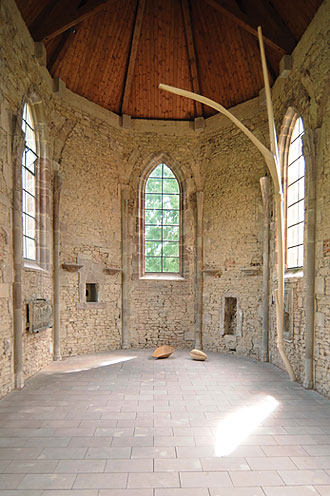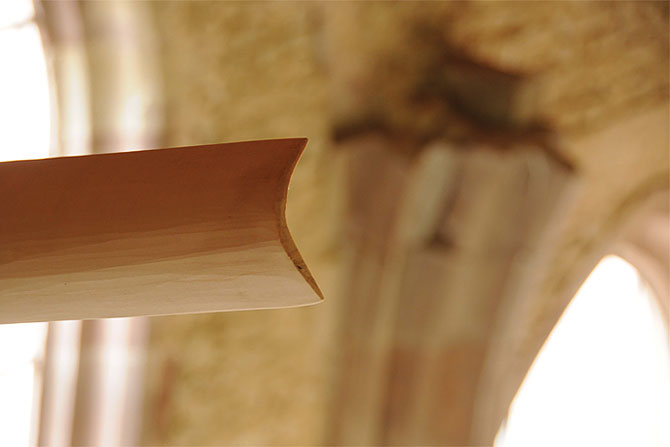The Limits to Growth
Hermann Bigelmayr
My sculptural work is based on the realization that a basic sociopolitical attitude focused on constant growth is ultimately harmful to us all. A fundamental reclassification of the elementary values of nature is inevitable. In a figurative sense, I understand the cultural site Wintringer Chapel, located in the middle of a biosphere reserve, as a laboratory in which I experiment with my art to spark a new - ecologically oriented - way of thinking.
Hermann Bigelmayr, 2011
The Limits to Growth report is not a work of despair, but rather a contribution to crisis prevention. It contains important approaches that enable a peaceful, fair and sustainable transformation to a global society. In my opinion, this change must be the ultimate goal.
Our vision lies in building a global community whose foundations are based on values that have been part of our collective consciousness since time immemorial, that have ensured our survival and have always stood the test of time: Respect for life, responsibility for future generations, protection of the human habitat, altruism nourished by mutual interest, appreciation of the dignity of man...
Prinz El Hassan Bin Talal/ President of the Club of Rome/ Amman, Jordan in June 2006


In 2010, the South German sculptor Hermann Bigelmayr accepted the invitation to develop an artistic work for the cultural site Wintringer Chapel at the Wintringer farm. For some time now, the main impetus for the artistic work of the sculptor Hermann Bigelmayr has been the reports of the "Club of Rome" on the state of humanity, which have been published since 1969 and repeatedly updated over a period of 30 years. They bear the supertitle "Die Grenzen des Wachstums/The Limits to Growth". The lead authors include the scientists Donella (2001) and Dennis Meadows.
Founded in 1968, the "Club of Rome" embodies a non-commercial organization of about 51 selected experts from the fields of economics, science, politics and public life. They operate on an interdisciplinary and supra-political basis with the aim of raising awareness of key global issues and their interrelationships in order to raise awareness of the global threats they pose to humanity, particularly among political decision-makers. The authors of the reports, which have been translated into 37 languages worldwide and sold millions of copies, tirelessly show that the stress limits of this planet, wherever they may lie, are being reached very quickly by exponential growth, and in some cases have already been exceeded! With the reaching or even exceeding of the growth limits the systems of the earth, which are necessary for survival, threaten to get out of balance and to collapse.

Bliesgau Biosphere Reserve - Preserving Habitat
Especially model regions, e.g. biosphere reserves, have in a worldwide network the chance but also the responsibility with their individual resources to develop possible solutions in creative processes and to feed them into the world context. Against this background, the sculptural work of Hermann Bigelmayr was created especially for the place and its responsibility as one of the 'model workshops' in the biosphere reserve Bliesgau. It is completed over a period of two years in the mirror of a topic-specific public discourse. At the end a summarizing publication is planned.
The cultural site Wintringer Chapel will thus for the first time respond artistically to the question of how to sustainably preserve living spaces and use the impulses to ask questions and think about solutions.

It is the way of man, a way through the spiritual center of mankind, a deeply felt conviction, which ultimately carries the only chance to prevent a now foreseeable collapse of systems necessary for survival. This is the central message of my work.
Hermann Bigelmayr
The work
The installation of the sculptor Hermann Bigelmayr quotes at the cultural site Wintringer Chapel under the title "The Limits to Growth" a seemingly through the floor of the chapel grown oversized wheat stalk, which has grown unchecked into the former vault of the late Gothic chapel, where it has broken off at a height of about nine meters. The construction of this wheat stalk originally consists of four maple trunks, which the artist carved out in filigree. Bigelmayr first developed a model on a scale of 1:20 in order to calculate the statics. The supporting structure of the broken stalk, its leaf, from which a piece has also broken off, as well as a last oversized grain of wheat lying on the ground, together with chaff, postulate the fatal consequences of a basic socio-political attitude that is oriented towards constant growth.

At the exit of the chapel, a single grain of wheat on a square of a "chessboard" refers to an ancient tradition that illustrates the danger of exponential growth... Likewise, the installation promotes a completely different evaluation of nature, which is not merely controllable matter, but an independent, living system in which man is integrated as part of it. In this sense, by thematically anchoring the wheat, Bigelmayr also wants to highlight the exemplary ecological agriculture of the Wintringer farm, which demonstrates economic advantages in a social and ecological operating system and contributes to the restoration of biodiversity. Ultimately, the stalk also sparks a dialogue with the collapsed Gothic vault of the old priory church. Related in essence to the "broken" wheat stalk, the old vault can only be glimpsed in the remains of the supporting wall columns or shield arches that originally bundled the cross ribs.
Every day of continued exponential growth pushes the world system closer to the limits of growth. By choosing to do nothing, one is in fact choosing to increase the dangers of collapse.
Dennis L. Meadows
Visual language
Hermann Bigelmayr's artistic ideas come from the center of his being. They are also an expression of his deep examination of the fundamentals of life and what it means to give this planet a chance in the future. It is obvious that in his mostly exaggerated works, the artist wants to make visible what has been repressed, at the latest at second glance. He makes the viewers become quiet, to look up, to feel his messages. By setting exaggerated signs, he wants to build bridges for the viewer to take a position for himself and then also to act himself.
For his installation at the cultural site Wintringer Chapel, Hermann Bigelmayr spent months in his huge studio, a former barn of an old farmhouse near Ulm: hours, days, weeks. Overshadowed by the catastrophe in Japan, Hermann Bigelmayr "struggled" on site with the self-understanding of his artistic position and his current work for the Saarland chapel... In this process, the wheat stalk emerged from the maple trunks - fragile, oversized, fragile.
Thus, at first the stalk appears in almost dance-like aesthetics in dialogue with the still recognizable medieval building structure and the light of the chapel; already in the next breath it appears strenuous and challenging, like a memorial, provocative and salutary at the same time. Hermann Bigelmayr uncompromisingly follows his artistic conscience; with his wooden sculpture he ultimately leads every attentive viewer to the question of the future of this planet, of human existence, and finally to the question of oneself.
The artist

Hermann Bigelmayr is a classically trained wood sculptor. According to his own words, he has a great affinity for the work of the late Gothic sculptor Tilman Riemenschneider, in whose formal language he already worked in his early years. He has become internationally known for his sensational, environmental projects with large sculptures in public spaces. Of particular note is a large sculpture that Bigelmayr realized in 1992 as the winner of an international competition in front of the GSF (Institute for Environment and Health) in Neuherberg near Munich. This monument to a culm also bears the title "The Limits to Growth" and lays the track of his artistic intention, which now sprouts again at the cultural site Wintringer Chapel and seeks its dialogue. Bigelmayr made a 30-meter-long sculpture from massive oak trees that were uprooted during hurricane Wiebke in 1990. It shows a stalk of wheat pressed to the ground, revealing nature as a fragile system that is collapsing under man's unrestrained drive for growth. A stalk sprouting up to the sky quotes the vitality of nature, which, however, only has a future with careful care by man...

| 2010 | Sea Lily Award of the City of Munich |
| 2010 | Teaching assignment Munich University of Applied Sciences, Department of Architecture |
| 2004- | lecturer at the summer academy in Neuburg/Donau |
| 2001-02 | Teaching assignment at the Munich University of Applied Sciences, Department of Architecture |
| 1998 | Pasinger Art Award |
| 1997 | workshop at the Sculpture Project Bagamoyo in Tanzania, Goethe Institute, Dar es Salaam |
| 1993/07 | Project funding of the Bavarian State Government for a sculpture in public space |
| 1988-90 | Assistant at the Academy of Arts in Munich with Prof. Hans Ladner |
| 1988 | Promotion award of the Bavarian State Government |
| 1984 | Promotion award of the city of Munich |
| 1984-85 | Foreign scholarship of the Study Foundation in Florence |
| 1982-83 | Scholarship for one year of the DAAD German Academic Exchange Service in Paris |
| 1982 | "Debutanten-Preis" of the Bavarian State Government |
| 1980 | Study Foundation of the German People |
| 1976-82 | Studies at the Academy of Art in Munich/Master student with Prof. Ladner/Diploma |
| 1958 | born in Jettingen |
With SCULPTURES IN PUBLIC SPACE, sculptor Hermann Bigelmayr brings together nearly 20 years of his work of large-scale sculptures in outdoor spaces.
Early on, Hermann Bigelmayr found the most natural material to lend his artistic intention the appropriate form of expression: oak wood. He may have been inspired by hurricane Wiebke, which in 1990 swept away even massive oak trunks, or he may have become thoughtful as a result of the environmental report of the "Club of Rome" on the "Limits to Growth".
Hermann Bigelmayr's massive oak sculptures create an almost compelling engagement with the environment. Hermann Bigelmayr attaches great importance to the spatial context of his works, explores the task and content of the place, goes in search of historical traces, examines the used material of the surrounding architecture. The surrounding space is incorporated into the sculpture, enters the consciousness of the viewer through the reciprocally formulated effect.
Anette Frankenberger, Munich

A single grain of wheat
... Every day of continued exponential growth pushes the world system closer to the limits of growth. By choosing to do nothing, one is in fact choosing to increase the dangers of collapse ...
The danger of exponential growth
To most people, growth appears to be a linear process. Linear growth occurs when a quantity increases by a constant amount in equal periods of time. Exponential growth, on the other hand, is when a quantity increases by a certain percentage of the previous quantity in equal periods of time. Exponential growth of this kind is a common phenomenon in biology, finance and very many other systems. Exponential growth is deceptive because even at relatively low growth rates, astronomical numbers are reached in a short period of time. Uncontrolled exponential growth has led mankind into crisis, it is at the limit of its earthly possibilities of existence.
There is the old tale of the courtier who gave his king an elaborate chessboard and humbly asked for only a single grain of corn for the first square as a reward, and for each subsequent square twice the number of grains as for the previous one, i.e., two grains for the second square, four for the third, and eight for the fourth. This corresponds to an exponential increase with a growth rate of one hundred percent; on the tenth field there are only 512 grains, but on the 21st over one million grains. There are not so many grains on earth as would have to be paid for the 64th field.


